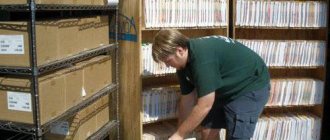Concept and types of trade
Trade is a separate branch of the economy associated with the process of transferring inventory, initially purchased for subsequent resale, for a fee from the seller to the buyer and includes a set of specific operations performed in this case.
There are 2 types of trade: wholesale and retail.
Wholesale trade is the transfer of goods and materials for a fee from the manufacturer (seller) to another seller for subsequent retail sale. Carried out in large quantities, usually at a lower price than retail.
Retail trade - single (piece) transfer of goods and materials for a fee to the end consumer.
Accounting in trade, retail and wholesale, differs both in its legislative approach and in the algorithm for reflecting business transactions. Let's look at these differences in more detail.
Grouping costs by economic elements
Used to analyze the financial results of an enterprise. It differs from classification by item in that all expenses are distributed according to types that characterize their economic content. Each economic element includes an extensive list of articles that are homogeneous in their economic content. For example, the element material costs. It includes items such as raw materials, fuel, tools, etc.
Such a classification makes it possible to determine the cost structure and the share of an individual element in the entire cost. Grouping by economic elements might look like this:
- Material expenses
- Depreciation
- Labor costs
- Depreciation
- Social contributions Needs
- other expenses
Since in 1C: Accounting 8.3. Since the “Cost Items” directory is hierarchical, you can create groups by economic elements.
However, grouping by cost elements does not allow determining the unit cost of production. Grouping costs by costing items serves this purpose.
Features of accounting in wholesale trade
Accounting in wholesale trade includes recording the facts of receipt, internal movement of goods and materials and final sale to the buyer for subsequent resale.
Receipt of goods and materials
Receipt of inventory items is recorded by the following records:
- Dt 41 Kt 60 - receipt of goods and materials;
- Dt 19 Kt 60 - input VAT is allocated.
It is accompanied by a delivery note in the TORG-12 form and an invoice.
According to PBU 5/01 (approved by order of the Ministry of Finance of Russia dated 06/09/2001 No. 44n), all direct costs associated with the purchase of inventory and materials must be included in their cost. Direct costs include:
- delivery;
- customs duties;
- mediation, information and consulting services;
- non-refundable taxes;
- insurance, etc.
Such expenses are reflected by posting: Dt 41 Kt 60.
IMPORTANT! Organizations that maintain simplified accounting can take into account direct costs associated with the purchase of inventory items as part of the costs of ordinary activities, provided that there are no significant balances in warehouses (clauses 13.1–13.3 of PBU 5/01).
Read about which companies have the right to use simplified accounting methods here.
Internal movement of goods and materials and other costs associated with preparation for sale
After receiving the goods at the warehouse, they can be moved to other divisions of the company. In this case, the costs of delivery between departments, storage and other similar costs are taken into account as part of expenses for ordinary activities. There may also be other costs associated with the sale (packaging, advertising).
These operations carried out with the involvement of third parties are reflected in accounting transactions:
- Dt 44 Kt 60 - services of third-party organizations (IP) are reflected;
- Dt 19 Kt 60 - input VAT is allocated.
These operations can also be carried out in-house. Then this will be expressed by postings:
Dt 44 Kt 70 (69, 10, 02, 76).
The last of the above entries also accrues general expenses associated with the maintenance of the management apparatus, retail and warehouse space, and own transport.
Sales of goods and materials
The sale of wholesale goods is usually carried out in large quantities to a specific buyer.
Wiring block:
- Dt 62 Kt 90.1 - sale of goods and materials to the buyer;
- Dt 90.3 Kt 68 - allocated VAT on sales;
- Dt 90.2 Kt 41 - write-off of sold inventory items at actual cost;
- Dt 90.2 Kt 44 – write-off of sales expenses.
Receipt of payment (and prepayment) for goods sold in bulk is usually carried out by non-cash means, which is reflected by the posting:
Dt 51 (52) Kt 62.
There are several cases when implementation needs to be taken into account using account 45. ConsultantPlus experts spoke about them. Get trial access to the system for free and go to the Ready-made solution.
Composition of expenses of a trading enterprise
Different points of view look at the distribution of costs from different angles, but the most common option is the one shown in the table.
| No. | Types of costs | Characteristic |
| 1 | Product cost | The cost of purchasing goods and additional expenses included in its cost |
| 2 | Other costs | This includes all additional expenses that were incurred by the company and are not included in the cost price. |
The most significant part is the part that goes towards the purchase of the product, but the more extensive the business activity, the more expenses it contains that are not related to purchases in any way. The machine helps and is aimed mainly at automating large businesses with a wide range of accounting operations and contributes to maintaining correct records of warehouses, increasing sales, analyzing the market situation, advertising a product, making payments to subordinates and other issues that require the attention of an accountant.
The difference between the cost blocks given in the table and the selling price of the product is very important:
- When a product arrives for sale, all the necessary information in the working form is pulled from the paper on which its receipt was previously carried out, and the machine itself carries out this regulated process.
- Other types of expenses are no exception and also fall under this process.
The user is obliged to note the procedure for accounting for expenses when determining the financial results of the company. To do this, in addition to the standard list of details, secondary ones are added to reflect the same type of costs in a variety of ways.
The machine allows you to keep track of expenses in a variety of areas, and you yourself have the right to determine the main ones and all the others that are included in them.
Specifics of accounting in retail trade
Accounting in retail trade is somewhat different from accounting for wholesale goods. This is due not only to the fact that sales are carried out in small batches or individually, but also to the predominance of cash payments.
Accounting for receipt of goods and materials
Retail organizations have the right to keep records of inventory items both at purchase prices and at sales prices with a separate accounting of markups (clause 13 of PBU 5/01).
IMPORTANT! The chosen accounting option should be recorded in the accounting policy.
For information on how accounting policies are formed, read the article “How to draw up an organization’s accounting policies (2020)?” .
If the store has accounting programs and special equipment, then records are kept for each type of inventory, and the program automatically writes off the cost of inventory at purchase prices (that is, quantitative and total accounting is maintained).
Well, for small shops and retail outlets that are not equipped with a software product, it is more convenient to keep records at selling prices, since this method is less expensive.
In this case, the markup is reflected on account 42 at the time of receipt of the goods.
Let's consider how transactions will differ when goods are received depending on the selected accounting price method.
| Accounting type | ||||
| At purchase prices | Content | At selling prices | ||
| Dt | CT | Dt | CT | |
| 41 | 60 | The goods have arrived | 41 | 60 |
| 19 | 60 | VAT allocated | 19 | 60 |
| Extra charge taken into account | 41 | 42 | ||
The entire amount of cash proceeds received is collected per day and recorded with the entry: Dt 50 Kt 90.1 - receipt of proceeds to the cash desk..
Sales accounting
The entire amount of revenue received is collected per day and in account 90.1 “Revenue” and is recorded as follows: Dt 50 Kt 90.1 - receipt of revenue to the cash desk.
Many stores install payment terminals for paying customers using bank cards. This type of settlement is called acquiring and is recorded by posting: Dt 51 (57) Kt 90.1.
After registering the revenue, it is necessary to show the disposal of the goods. This fact is reflected by the entry: Dt 90.2 Kt 41.
Since inventory items are listed on account 41 at selling prices, it turns out that the amount of revenue and the amount of write-off of goods are equal, so it is necessary to additionally take into account the sold margin. This is done by wiring: Dt 90.2 Kt 42 (reversible). The realized markup is the gross income of the business and is called the realized overlay.
Let's look at the differences in postings depending on the chosen price accounting method.
| Accounting type | ||||
| At purchase prices | Content | At selling prices | ||
| Dt | CT | Dt | CT | |
| 50 (51, 57) | 90.1 | Revenue received | 50 (51, 57) | 90.1 |
| 90.3 | 68 | VAT charged on revenue | 90.3 | 68 |
| 90.2 | 41 | Cost of goods sold written off | 90.2 | 41 |
| Realized markup written off | 90.2 | 42 (reversible) | ||
According to clause 12 of the Methodological Recommendations for accounting and registration of operations for the receipt, storage and release of goods in trade organizations (letter of Roskomtorg dated July 10, 1996 No. 1-794/32-5), the realized overlay is determined by calculation when accounting for inventory items at selling prices.
Calculation is carried out in 4 ways:
- Based on total trade turnover.
- Assortment of commodity turnover.
- Average percentage
- Assortment of remaining inventory items.
The procedure and calculation formulas for each method can be found in the material “How to correctly calculate gross income?”
The selected calculation option must be reflected in the company's accounting policies.
The most convenient and frequently used method is the average percentage calculation.
The implemented overlay is calculated, usually at the end of the month, using the following formulas:
Mon = (Nstart + Npost – Nset) / (Tob + Remaining) × 100%,
Where:
Mon—percentage of realized margin;
Nnach - opening account balance 42;
Npost - the amount of the received markup (credit turnover of account 42);
Nvyb - the amount of discounts, markdowns and other operations that reverse account 42;
Tob - revenue;
Residual — balance of inventory items at the end of the billing period.
Рн = Mon × Tob,
Where:
Рн — implemented overlay.
The amount received is recorded as follows: Dt 90.2 Kt 42 (reversal).
For each sale, the seller is required to enter a cash receipt. This document reflects the amount of VAT, and it eliminates the need to issue an invoice (clause 7 of Article 168 of the Tax Code of the Russian Federation). And a cash register report for the shift is entered into the purchase book.
This rule applies exclusively to cash payments. If the money is credited to the current account, the seller is obliged to draw up an invoice within 5 days (clause 3 of Article 168 of the Tax Code of the Russian Federation).
You will find more nuances regarding VAT in retail trade in the Ready-made solution from ConsultantPlus, having received free trial access to the system.
Attribution of expenses to the cost of production
The most extensive cost item related specifically to this block is transportation and procurement costs (TPC). But before you attribute your costs to this part, decide:
- where do the goods come from, the cost of which will be included in the TZR;
- what principles will be applied during the procedure.
The first question discussed is hidden in the spend analytics worksheet:
- It may be that your TKR are taken into account in the analytics as the receipt of goods and services, and if you register the carrier’s services here, the machine will request a link to the paper on which its services were provided and will itself distribute the costs of the goods;
- There are companies that work with third parties based on orders. Then you should pull up that order from the article Order to Supplier here and, when registering it, write down the paper for this order. The machine will independently select all items of the goods and services receipt form that have a link to the selected order and then distribute the costs of the product according to the regulations;
- in a situation where you need to set up an article to display expenses for warehouse repairs. Accordingly, the analytics in this case will be the warehouse. The specified amount will be attributed to the goods in the remainder of the warehouse where the repair is expected to be carried out.
Typical postings in trade organizations
Example 1
LLC "Versal" is engaged in wholesale trade in cement.
On February 1, the goods arrived - 2,835 bags (50 kg each). Price — 187 rub. for a unit. A total of 530,145 rubles. (including VAT RUB 88,357.50).
Direct costs were: delivery - 53,350 rubles. (including VAT RUB 8,961.67).
Cement was sold in the amount of 1,847 pieces. in the amount of 561,750 rubles. (including VAT RUB 93,625.00). The costs of delivering goods and materials to the buyer under the contract are at the expense of the seller in the amount of 43,467 rubles. (including VAT RUB 7,244.50).
| Dt | CT | Amount, rub. | Calculation | Detailing |
| 41 | 60 | 441 787,50 | 530 145 – 88 357,50 | The goods have arrived |
| 19 | 60 | 88 357,50 | VAT allocated | |
| 41 | 60 | 44 388,33 | 53 350 – 8 961,67 | Delivery services have arrived |
| 19 | 60 | 8 961,67 | VAT allocated | |
| 62 | 90.1 | 561 750 | Sales of goods | |
| 90.3 | 68 | 93 625,00 | VAT on sales | |
| 90.2 | 41 | 316 743,12 | (441 787,50 + 44 388,33) / 2835 × 1847 | The cost of cement is written off |
| 44 | 60 | 36 222,50 | 43 467 – 7 244,50 | Delivery costs to the buyer are taken into account |
| 19 | 60 | 7 244,50 | Input VAT on delivery services to the buyer | |
| 90.2 | 44 | 36 222,50 | Write-off to the cost of delivery services to the buyer |
The cost of cement sold was RUB 352,956.62. (316,743.12 + 36,222.50).
The financial result of these operations is visible when forming SALT for account 90. Let's consider it in more detail.
| Check | Name | Opening balance | Turnover for the period, rub. | Final balance, rub. | |||
| Dt | CT | Dt | CT | Dt | CT | ||
| 90.1 | Revenue | 561 750,00 | 561 750,00 | ||||
| 90.2 | Cost price | 352 956,62 | 352 956,62 | ||||
| 90.3 | VAT | 93 625,00 | 93 625,00 | ||||
| 90.9 | Profit/loss | 115 168,38 | 115 168,38 | ||||
Thus, the gross income of Versailles LLC for February 2021 amounted to 115,168.38 rubles.
Example 2
Demetra LLC is engaged in retail trade in food products. The company applies a special UTII regime and does not pay VAT.
The stores are not equipped with special programs, and records are kept at sales prices (total). Every ten days, store managers submit commodity and cash reports (hereinafter referred to as TAR) to the accounting department with the attachment of primary documents.
For the 1st decade of July, store No. 1 passed the TAR with the following data:
| Operation | Amount with extra charge, rub. | Cost, rub. | Markup, rub. |
| Balance as of June 30 | 466 773,57 | 133 587,33 | |
| Coming | 589 793,10 | 453 687 | 136 106,10 |
| Total consumption: | 510 672,60 | ||
| including cash revenue | 387 336,77 | ||
| including non-cash revenue | 123 335,83 | ||
| Balance as of 10.07 | 545 894,07 |
Postings:
| Dt | CT | Amount, rub. | Detailing | Note |
| 41 | 60 | 453 687 | Receipt of goods and materials | To be entered for each counterparty |
| 41 | 42 | 136 106,10 | Extra charge | |
| 50 | 90.1 | 387 336,77 | Proceeds received at the cash register | |
| 51 | 90.1 | 123 335,84 | Receipt of proceeds to the account | |
| 90.2 | 41 | 510 672,60 | The cost of inventory items is written off at selling prices |
Calculation of the implemented overlay:
- (133 587,33 + 136 106,10) / (510 672,60 + 545 894,07) × 100% = 25,52%;
- 510,672.60 × 25.52% = RUB 130,323.65
That is, gross income is recorded by reversing entry Dt 90.2 Kt 42 in the amount of RUB 130,323.65.
Nuances of cost sharing
Regardless of the method you choose to attribute expenses incurred, it is important and necessary to take into account the following points:
- With a multi-stage cost system, it is useful to indicate in the name of the expense not only its purpose, but also the principle of its distribution.
2. The help menu has its own gradation and a couple of expense items with existing distribution and analytics algorithms can be combined into groups.
3. Expensive articles can be configured to limit access to them. If, for example, the article states that payments are made only through the company’s cash desk, then in the working form the switch for limiting use in business operations is activated, and in the field of available transactions, deactivate all other switches in addition to the issuance of funds for other expenses. When you do everything correctly, the item will only be visible in the cash receipt.
Results
Accounting in trade organizations depends on the type of trade: wholesale or retail. At the same time, in retail outlets equipped with a special software product, accounting is carried out automatically at the cost of each unit of goods, that is, quantitatively.
If the point is not automated, then in retail it is allowed to keep records only in total terms at retail prices with a designated markup. In this case, the financial result of the company’s work is determined by calculation.
The chosen accounting option is necessarily recorded in the accounting policy.
Sources:
- Tax Code of the Russian Federation
- Order of the Ministry of Finance of Russia dated 06/09/2001 No. 44n
- Methodological recommendations for accounting and registration of operations of receipt, storage and release of goods in trade organizations
You can find more complete information on the topic in ConsultantPlus. Free trial access to the system for 2 days.
Costs of areas of activity
The machine offers the user a special command for working with expenses in the company's business areas called the distribution rule. You can choose from the following options here:
- Proportional to cost.
- Proportional to quantity.
When working with product movements, only the second method should be used. In this case, you will not be able to accurately calculate the cost, since the machine finds it out only when carrying out regulations.
What determines the size of business expenses?
The main categories of costs and factors influencing their formation should be considered:
- Delivery of products. Depends on the distance of transportation, transport tariffs of the company, weight of the cargo, as well as the type of vehicle.
- Loading and unloading. They change due to a decrease or increase in the weight of products, as well as prices for this service per ton of goods.
- Packaging materials and containers. Their cost is determined by quantity and price per piece. The first indicator is related to the volume of production and the required materials to package one unit. The commercial expenses of an enterprise of this type are among those that are undesirable to exclude. This is due to the fact that aesthetically attractive packaging is one of the factors increasing demand for a product, so savings in this case are undesirable. Costs in this category will be repaid by increased sales. This can also be said about the study of sales markets, advertising and other marketing research.
After all business expenses have been analyzed, it is necessary to determine ways to reduce them, as well as develop clear recommendations for mastering this procedure.





